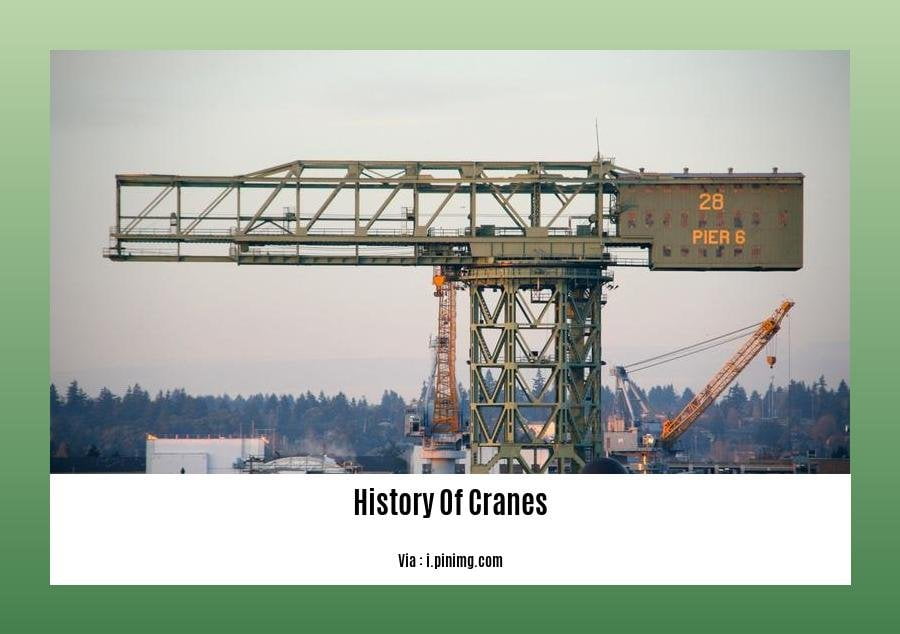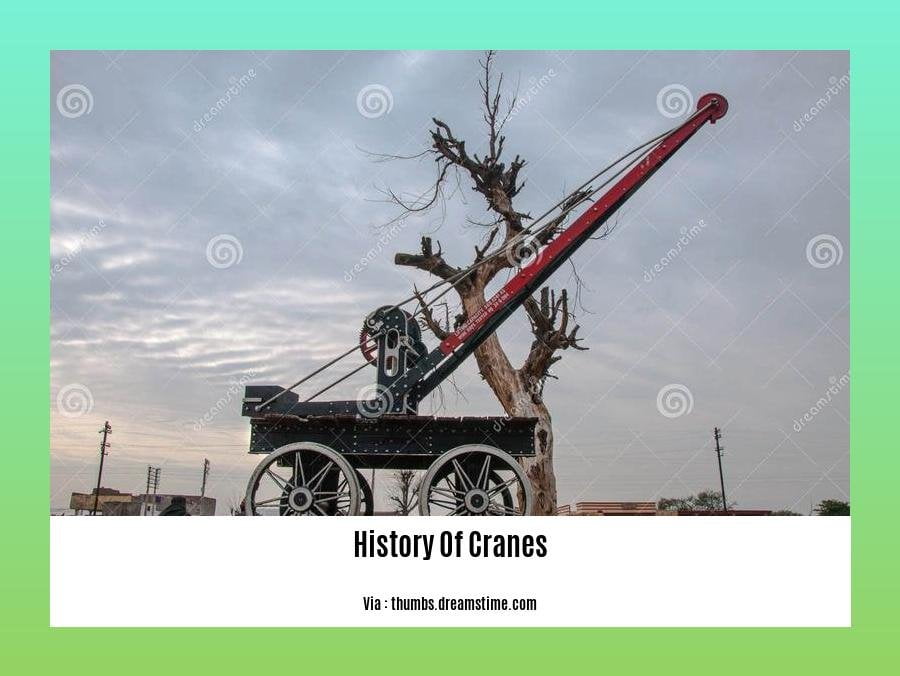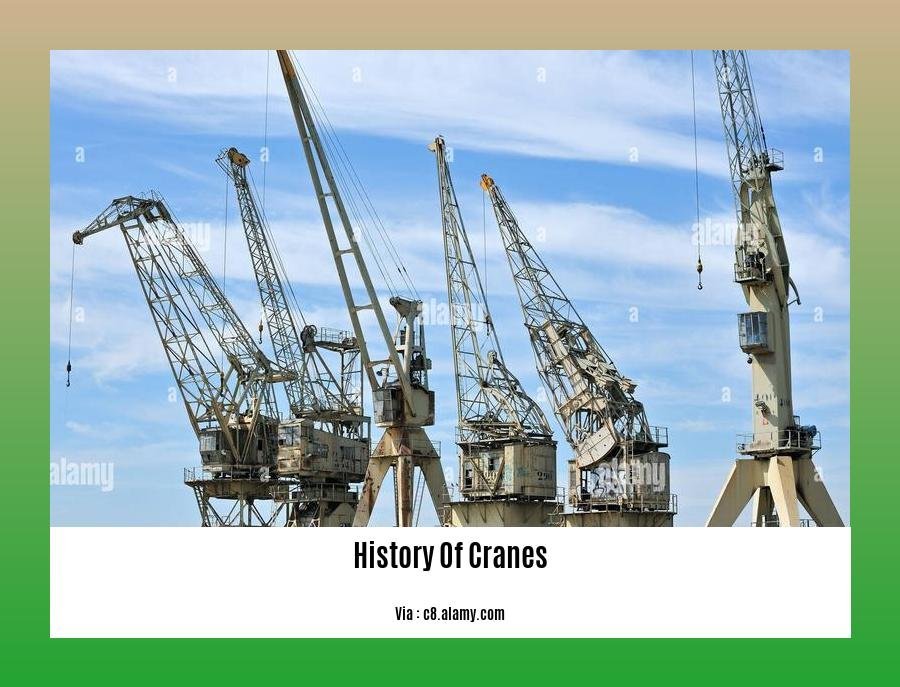Step into the captivating world of engineering marvels with “Unveiling the Legacy of Ingenuity: A Journey Through the History of Cranes.” From the rudimentary crane-like machines in ancient Greece to the towering modern marvels reshaping skylines, this article embarks on an enthralling voyage through the ages, exploring the remarkable evolution of these indispensable tools.
Key Takeaways:
- Cranes are machines used for lifting and moving heavy objects using ropes, cables, and sheaves.
- The earliest known cranes were invented in ancient Mesopotamia and ancient Egypt, around 3000 BC and 2000 BC respectively.
- Throughout history, cranes have evolved from simple water-lifting devices to powerful machines used in construction, transportation, and manufacturing.
- Cranes use mechanical advantage to lift and move loads beyond human capabilities.
- In ancient Greece, cranes were powered by men or animals and used for construction.
- The Romans developed larger cranes using human treadwheels to lift heavier weights.
- During the High Middle Ages, harbor cranes were introduced for loading and unloading ships and aiding in construction.
- Modern cranes are highly advanced, equipped with sophisticated controls and safety features, servicing various industries.
History of Cranes


From the bustling construction sites of ancient civilizations to the towering skyscrapers of today, cranes have played a pivotal role in shaping the built environment. Their journey through history is marked by ingenuity, innovation, and a relentless pursuit to reach new heights.
Ancient Origins
The earliest known cranes were simple devices used for lifting water and other heavy objects. The shadouf, invented in ancient Mesopotamia around 3000 BC, consisted of a pole with a bucket attached to one end and a counterweight on the other. This simple machine provided farmers with a means to irrigate their fields and manage water resources efficiently.
Evolution in Ancient Greece and Rome
The ancient Greeks expanded on the concept of cranes, using them for construction purposes. They harnessed animal power, particularly oxen, to operate these devices, enabling them to lift heavier loads. Cranes became an essential tool in the construction of temples, theaters, and other architectural marvels that continue to inspire awe today.
The Romans further refined crane technology, developing larger and more powerful versions capable of lifting heavier weights. They introduced the treadmill crane, powered by human labor, which significantly increased lifting capacity. These advancements facilitated the construction of grand structures like the Colosseum and the Pantheon, testaments to the Romans’ engineering prowess.
Medieval Harbor Cranes
During the High Middle Ages, a new type of crane emerged – the harbor crane. These cranes were specifically designed for loading and unloading ships, expediting the movement of goods and facilitating trade. They marked a significant milestone in the history of cranes, contributing to the growth of maritime commerce and the rise of port cities.
Cranes in the Industrial Revolution
The 19th century witnessed a surge of innovation in crane technology, driven by the Industrial Revolution. Steam power revolutionized the operation of cranes, providing them with greater lifting capacity and efficiency. The development of steam-powered cranes coincided with a period of rapid industrialization, enabling the construction of bridges, railroads, and factories that fueled economic growth.
Modern Cranes: A Symphony of Technology
In the 20th century, cranes evolved into highly sophisticated machines, incorporating advanced controls, safety features, and automation. Electric and hydraulic power replaced steam, providing cranes with greater precision and ease of operation. Tower cranes became ubiquitous on construction sites, enabling the construction of ever-taller buildings. Mobile cranes, with their versatility and maneuverability, revolutionized the transportation and lifting industries.
Today, cranes continue to push the boundaries of innovation, catering to a diverse range of industries and applications. From towering lattice boom cranes that grace skylines to compact mini cranes that navigate confined spaces, these machines have become indispensable tools in our modern world.
The Future of Cranes
As technology continues to advance, the future of cranes is poised for even greater evolution. Autonomous cranes, equipped with artificial intelligence and sensors, are on the horizon, promising enhanced safety, efficiency, and productivity. The integration of sustainable technologies, such as hybrid and electric power sources, will further reduce the environmental impact of these magnificent machines.
The history of cranes is a testament to human ingenuity and the relentless pursuit of progress. From their humble origins as water-lifting devices to the complex marvels of modern engineering, cranes have transformed the way we build, transport, and shape our world. Their legacy continues to inspire and empower us as we strive to reach new heights, both literally and figuratively.
- Want to know how cranes evolved and their role in construction industry? Explore the history of cranes machine.
- Did you know dreadlocks originated in ancient Egypt and were associated with religious practices? Learn more about the history of dreadlocks slavery.
- Ever wondered how fabric printing came to be? Uncover the fascinating history of fabric printing.
Cranes in Ancient Rome
Cranes in Ancient Rome played a pivotal role as versatile tools in the construction of iconic structures that have stood the test of time. From majestic temples to towering aqueducts, these ingenious machines enabled the Romans to achieve remarkable feats of engineering that continue to inspire awe in modern times.
Evolution of Roman Cranes
Primitive Beginnings:
The Romans initially adopted the basic crane design from the Greeks, which utilized simple tongs to lift heavy blocks. These early cranes were powered by human labor, with teams of workers pulling ropes to raise and lower loads.
The Polyspaston Crane:
A significant innovation in crane technology came with the invention of the Polyspaston crane. This ingenious device employed a system of multiple pulleys, arranged in a block-and-tackle configuration. By distributing the load across several pulleys, the Polyspaston crane significantly reduced the force required to lift heavy objects.
Incorporating Treadwheels:
To further enhance the lifting power of cranes, the Romans incorporated treadwheels into their design. These large wheels were powered by human or animal effort, providing a more efficient and continuous source of power. The treadwheels allowed cranes to lift even heavier loads with greater ease and efficiency.
A Glimpse into Roman Ingenuity:
The Polyspaston crane, combined with the power of treadwheels, enabled the Romans to achieve remarkable feats of engineering. These cranes were capable of lifting and transporting massive stone blocks weighing several tons, which were essential for constructing their grand structures.
Notable Achievements in Roman Architecture
The Colosseum:
The Colosseum, an iconic symbol of ancient Rome, is a testament to the Romans’ engineering prowess. Its construction involved lifting and positioning massive blocks of stone, which were precisely cut and fitted together without the use of mortar. Cranes played a crucial role in this process, enabling the efficient movement of these colossal building blocks.
The Pantheon:
The Pantheon, with its awe-inspiring dome, is another architectural marvel that showcases the Romans’ mastery of crane technology. The massive dome was constructed using a lightweight concrete material, which was poured into formwork supported by cranes. The use of cranes allowed the Romans to achieve the dome’s remarkable size and structural integrity.
Key Takeaways:
The Romans adopted and improved upon the Greek crane design, creating more powerful and efficient machines for construction.
The Polyspaston crane, with its system of pulleys, reduced the force required to lift heavy objects.
Treadwheels, powered by human or animal effort, provided a continuous source of power for cranes.
The combination of the Polyspaston crane and treadwheels enabled the Romans to lift and transport massive stone blocks.
Cranes played a vital role in the construction of iconic Roman structures such as the Colosseum and the Pantheon.
Sources:
Evolution of a Crane and Hoist in Ancient Rome
FAQ
Q1: What were the earliest forms of cranes?
A1: In ancient Greece, iron tongs were used as primitive cranes to lift and move heavy stone blocks, while in ancient Egypt, cranes were used to construct pyramids using relatively lighter stones.
Q2: How were cranes used in ancient Rome?
A2: The Romans adopted and improved upon the Greek crane design, using it for various construction projects. They developed the Polyspaston crane, which could lift up to 3000 kg using four men working on a winch. When combined with a treadwheel, the lifting capacity could be doubled.
Q3: What was the role of cranes in the construction of Stonehenge?
A3: Cranes were used to transport and lift the large stones used in the construction of Stonehenge. The heaviest stone weighed approximately 50 tons.
Q4: What are some of the modern uses of cranes?
A4: Modern cranes are used in various industries, including construction, transportation, and manufacturing. They are used to lift and move heavy loads, with capacities ranging from a few tons to hundreds of tons.
Q5: How have cranes evolved over time?
A5: Cranes have evolved from simple devices powered by humans or animals to sophisticated modern cranes that use advanced technology. They have become more powerful, efficient, and safer, with increased lifting capacities and precision control.
- Georgia Platform: A Southern Strategy, 1850s - March 31, 2025
- How many weeks is 40 days: Quick Conversion Guide for Accurate Results - March 31, 2025
- How many feet is 300 meters? 984 Feet: Understand Length Conversions Easily - March 31, 2025
















